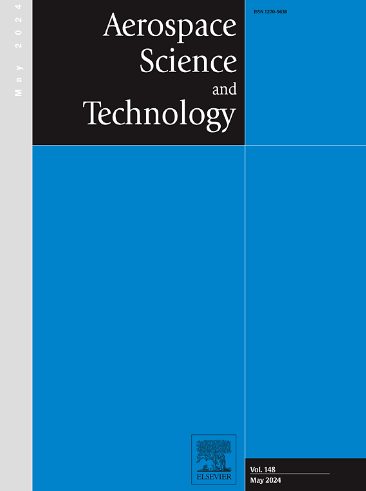受环境负荷影响的转子支撑系统动态特性模拟方法
IF 5
1区 工程技术
Q1 ENGINEERING, AEROSPACE
引用次数: 0
摘要
为研究航空发动机转子系统在环境负荷(温度和空气动力)作用下的动态特性,提出了一种改进的有限元方法。根据轴元件内的轴向温度分布,建立了材料物理性质的多项式。根据季莫申科梁理论,完成了热负荷下系数矩阵和考虑轴向空气动力的拉伸刚度矩阵的推导。模拟了工作温度为 200∼600∘C 的高压转子,空气动力大小为 105N。此外,该转子支撑系统采用了挤压薄膜阻尼器(SFD),其稳定响应采用等效系数法求解,瞬态响应采用 Newmark-HHT 法求解。结果表明,前两个临界转速分别降低了 1.85 % 和 2.07 %,这主要是由热负荷引起的。温度升高导致弹性模量降低,泊松比和膨胀比升高。当位于第一级压缩机盘(CD1)的质量不平衡量为 500 g-mm 时:CD1 和涡轮机盘(TD)的第一共振峰分别增加了 4.56 % 和 4.98 %,CD1 和 TD 的第二共振峰分别增加了 5.88 % 和 5.00 %。由于 SFD 的阻尼作用,CD1 和 TD 的前两个共振峰分别降低了 69 % 和 51 %。与 40 °C 相比,在油温 100 °C 时,CD1 处的前两个共振峰分别增加了 88 % 和 55 %。在较高温度下,由于油的粘度较低,油膜阻尼明显降低。在一阶临界转速附近运行时,转子的瞬态响应表现为简单谐波、圆前倾轨迹、主导旋转频率和周期性运动。总体而言,转子-SFD-支撑系统在环境负荷下的动态特性可以通过所提出的模拟方法进行预测。本文章由计算机程序翻译,如有差异,请以英文原文为准。
Simulation method for dynamic characteristics of rotor-support system subjected to environmental loads
An improved finite element method was proposed to investigate the dynamic characteristics of rotor system with environmental loads (temperature and aerodynamic forces) in aeroengines. According to the axial temperature distribution within shaft elements, the polynomials were established for physical properties of material. The derivation for coefficient matrices under thermal loads, and the tensile stiffness matrix considering axial aerodynamic forces were completed, based on the Timoshenko beam theory. A high-pressure rotor was simulated with operating temperature , and the magnitude of aerodynamic force is . Furthermore, a squeezed film damper (SFD) was adopted to this rotor-support system, its steady responses were solved by the equivalent coefficient method, and the Newmark-HHT method was utilized to solve the transient responses. The results indicate that the first two critical speeds are reduced by 1.85 % and 2.07 %, which is mainly caused by thermal loads. The rising temperature leads to lower elastic modulus, higher Poisson's ratio and expansion ratio. With the amount of a mass unbalance being 500 located at the 1st-stage compressor disk (CD1): the 1st resonance peaks at CD1 and turbine disk (TD) increase by 4.56 % and 4.98 %, respectively, and the 2nd resonance peaks at CD1 and TD rise 5.88 % and 5.00 %, separately. Owing to SFD damping, the first two resonance peaks at CD1 and TD decrease by 69 % and 51 %, respectively. Compared to 40 °C, the first two resonance peaks at CD1 increase by 88 % and 55 % at the oil temperature 100 °C. The oil-film damping deteriorates significantly due to the lower oil viscosity in higher temperature. When operating near the first-order critical speed, the transient responses of rotor perform as simple harmonics, circular precession trajectory, dominant rotational frequency, and periodic motions. Overall, the dynamic characteristics of rotor-SFD-support systems exposed to environmental loads can be predicted by the proposed simulation method.
求助全文
通过发布文献求助,成功后即可免费获取论文全文。
去求助
来源期刊

Aerospace Science and Technology
工程技术-工程:宇航
CiteScore
10.30
自引率
28.60%
发文量
654
审稿时长
54 days
期刊介绍:
Aerospace Science and Technology publishes articles of outstanding scientific quality. Each article is reviewed by two referees. The journal welcomes papers from a wide range of countries. This journal publishes original papers, review articles and short communications related to all fields of aerospace research, fundamental and applied, potential applications of which are clearly related to:
• The design and the manufacture of aircraft, helicopters, missiles, launchers and satellites
• The control of their environment
• The study of various systems they are involved in, as supports or as targets.
Authors are invited to submit papers on new advances in the following topics to aerospace applications:
• Fluid dynamics
• Energetics and propulsion
• Materials and structures
• Flight mechanics
• Navigation, guidance and control
• Acoustics
• Optics
• Electromagnetism and radar
• Signal and image processing
• Information processing
• Data fusion
• Decision aid
• Human behaviour
• Robotics and intelligent systems
• Complex system engineering.
Etc.
 求助内容:
求助内容: 应助结果提醒方式:
应助结果提醒方式:


